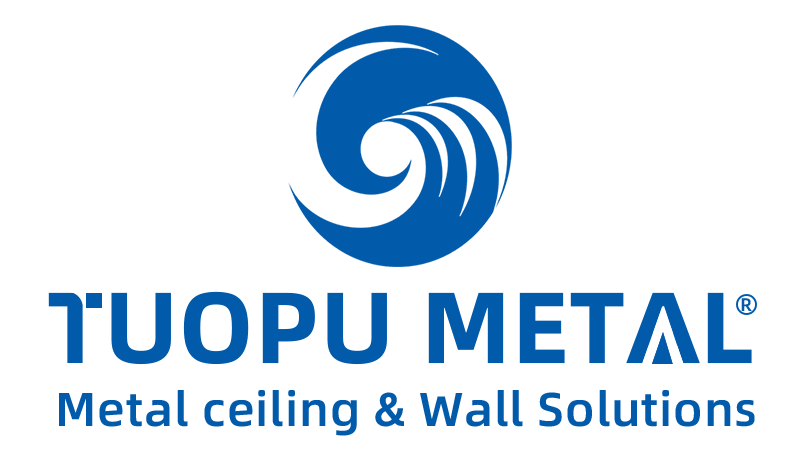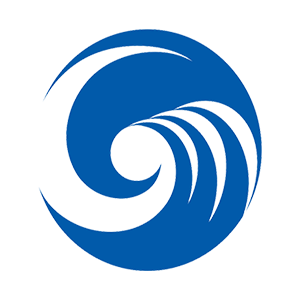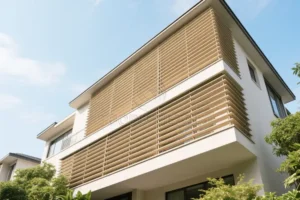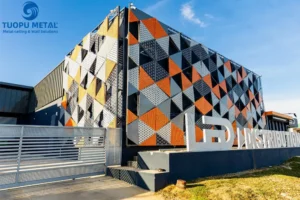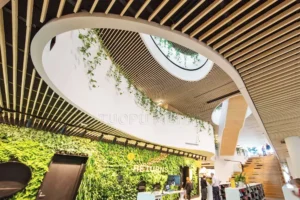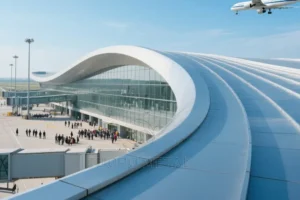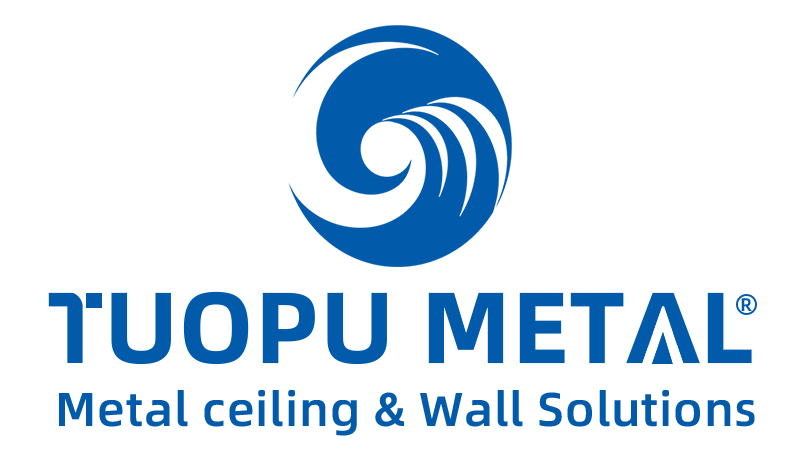Ceilings have evolved from underappreciated accents to significant design components that establish a room’s atmosphere. By 2025, ceiling design will be all about pushing the envelope with trends that emphasize cutting-edge technology, sustainability, and functionality.To create dynamic, contemporary spaces, architects and designers are adopting cutting-edge concepts that highlight ceilings and combine eco-friendly materials, clever features, and creative expression.
Sustainability Leads: Sustainable Ceilings

Ceilings are becoming an increasingly important component of eco-friendly design as sustainability continues to take center stage in architecture. Reclaimed wood and metals, as well as other eco-friendly alternatives, are among the materials that are being used in modern ceilings. By lowering waste and revitalizing outdated materials, these materials not only give spaces a distinctive look but also contribute to a greener future. These materials blend style and environmental responsibility, whether it’s the industrial appeal of recycled metal panels or the rustic charm of salvaged wood beams.
The eco-ceiling revolution is also led by designs that use less energy. Spaces can benefit from creative illumination and energy cost savings by incorporating LED lighting systems into ceiling structures. Some cutting-edge ceiling designs even incorporate photovoltaic cells or solar panels, turning ceilings into subtly functional energy sources. These systems preserve a building’s sleek, contemporary appearance while lowering its carbon footprint.
Eco-friendly ceilings have financial and environmental advantages for designers and builders. They lower building owners’ long-term operating costs and help achieve sustainability goals by contributing to green building certifications. In addition to staying ahead of trends, builders provide clients with long-term value by utilizing sustainable materials and energy-saving features. Selecting environmentally friendly ceiling options guarantees that functionality and design meet the requirements of contemporary, sustainable architecture.
Maximalism Reigns: Bold Patterns and Statement Ceilings
Making a statement is the main goal of maximalist ceiling designs. Rich textures and intricate patterns, such as bold geometric shapes or elaborate coffered ceilings, give any space a sense of grandeur and sophistication. These ceilings change from being merely overhead elements to striking focal points that help define a room’s personality.
Another important component of this trend is the use of vibrant colors. Multicolored gradients, earthy tones, and deep blues give the space vitality and individuality while evoking a sense of depth and movement. Once a passive component, the ceiling is now the interior’s most dynamic feature.
For architects and builders, maximalism offers an exciting opportunity to push creative boundaries. This trend lets you design spaces that feel luxurious, expansive, and full of character. Whether it’s a residential masterpiece or a bold commercial space, statement ceilings provide a way to elevate the overall design and make a lasting impression.
Material Fusion: Mixing Elements to Create Layered Beauty

A popular design trend involves combining metal and wood, as well as adding the silky smoothness of metal to create a contemporary aesthetic. The options for incorporating wood accents on the metal ceiling or wooden beams with brass panels are available. A mix of colors and materials will give any room a modern yet cozy feel.
The faux wood finishes from Tuopu Metal are the perfect answer for people who adore the appearance of wood but are worried about upkeep and durability. These finishes are ideal for both residential and commercial spaces because they combine the dependability and low maintenance of architectural aluminum with the natural beauty of wood.
Together with metal and wood, glass panels and fabric-wrapped components give ceilings an open, airy feel that improves acoustics and gives the impression of lightness. By addressing both aesthetic objectives and functional requirements like longevity, soundproofing, and ease of maintenance, this material fusion trend offers design versatility. This gives designers and builders countless options for creative, useful, and eye-catching ceiling solutions.
The Rise of Smart Ceilings: Tech Integration Above

Modern technology that improves functionality and changes spaces is the key to the future of ceiling design, which is no longer just about aesthetics. Smart features that go beyond conventional lighting are now being incorporated into modern ceilings. These days, ceilings are made to be as smart as they are beautiful, with features like climate control systems, automated lighting configurations, concealed speakers, and even fire suppression systems. These technologically advanced designs produce more practical, effective spaces that address the demands of both the environment and the occupants.
Projection mapping is among the most fascinating developments in ceiling technology. Modern projection systems can be used to turn ceilings into dynamic, interactive works of art. There are countless ways to customize projection mapping, whether it’s a starry sky in an opulent home or a breathtaking visual display in a museum or retail establishment. The way ceilings are used in homes and businesses is being completely transformed by this trend, which makes them the center of innovation and creativity.
The emergence of smart ceilings presents designers with an exciting chance to create environments that are tech-driven and truly integrated. The ceiling transforms from an overhead element to an integral component of the experience, augmenting the atmosphere and practicality of a room. Designers can create innovative solutions that appeal to clients looking for efficiency, convenience, and a futuristic atmosphere by integrating smart technologies. These creative ceilings enhance the design of both residential and commercial projects, adding interactivity and a seamless integration with the contemporary world.
Curved Ceilings: Organic Shapes in Modern Architecture
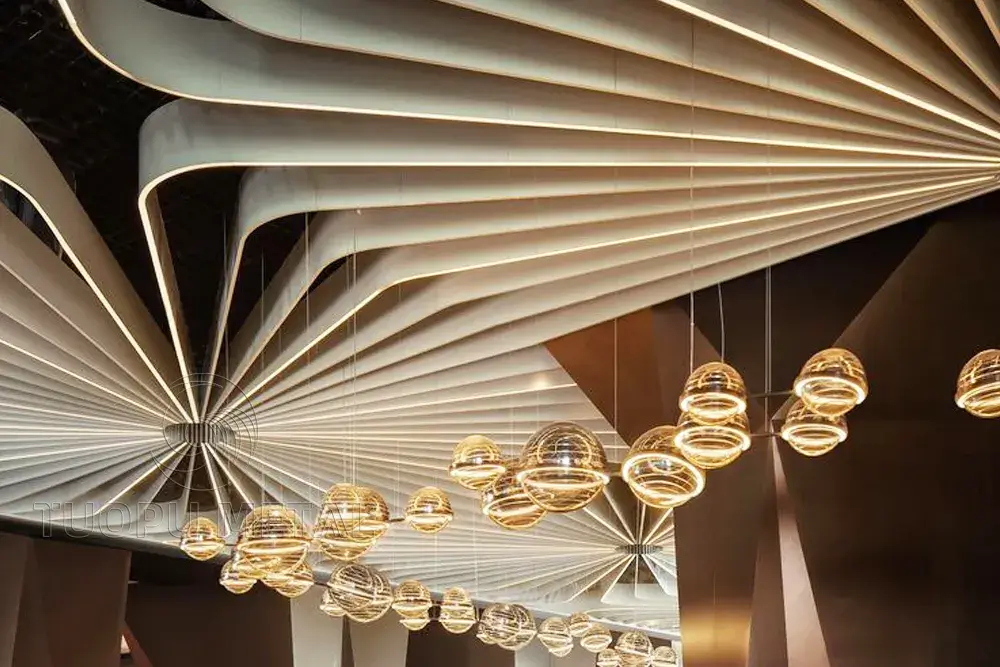
Curved ceilings, including domed and barrel-vaulted styles, are becoming very popular again. These forms create more dynamic and engaging spaces by improving acoustics in addition to adding height and grandeur. The rooms feel more balanced and cozy thanks to the gentle curves that help direct sound.
Free-form, organic curves that draw inspiration from nature are also becoming more and more popular. By adding a feeling of softness and fluidity, these asymmetrical, flowing shapes turn areas into welcoming settings. These designs’ ability to provide visual interest without overpowering the space is what makes them so lovely.
For builders and designers, curved ceilings are a dream. They help break up the rigidity of traditional flat ceilings, offering a dramatic visual impact that makes spaces feel more intimate and contemporary. This trend is perfect for projects that aim to marry aesthetics with functionality, providing a unique and elegant solution for modern interiors.
Minimalism with a Twist: Subtle Textures for Modern Ceilings
Minimalist ceilings aren’t just simple—they’re designed to play with light and shadow. Subtle textures, like soft relief patterns or finely crafted plaster, add depth and dimension, transforming the ceiling into a dynamic element that changes the room’s mood with the shifting light.
Monochrome tones, in soft neutrals or muted shades, set a calm and serene atmosphere. These ceilings serve as a sophisticated backdrop, complementing any interior style while maintaining a sense of elegance and tranquility.
For designers, textured minimalist ceilings offer the perfect balance. They introduce refined details without overwhelming the space, creating an understated elegance that works well in both residential and commercial designs. The simplicity allows for creativity in other elements of the room, while the ceiling remains a quietly striking feature.
Artistic Ceilings: Function Meets Creativity

By 2025, ceilings will have evolved into dynamic works of art rather than merely being overhead features. Interactive lighting systems and kinetic sculptures are converting ceilings into captivating, dynamic experiences. These installations offer both aesthetic appeal and practicality by adjusting to their surroundings.
Acoustics is a key component of some creative ceiling designs, which also serve as sound-absorbing artwork. These creative solutions are ideal for settings where both design and functionality are important, such as theaters, restaurants, or offices, because they not only improve a space’s appearance but also its sound quality.
Artistic ceilings give designers a distinct creative advantage. Ceilings are a distinctive element in both commercial and residential spaces because they enable the blending of form and function. With these designs, you can provide customers with something genuinely unique that gives their interior personality and functionality.
Conclusion
Modern interior design will increasingly incorporate ceilings as a basic overhead covering, with many more features expected to be included by 2025. The use of these trends enables architects, builders, and designers to create truly innovative spaces through the use of “green” materials, bold patterns, and smart technology. Despite being overshadowed by the “fifth wall,” ceilings are now considered an essential aspect of design. We must now fully embrace the future of ceilings.
About Tuopu Metal: Professional Custom Aluminum Ceiling Manufacturer & Supplier
Tuopu Metal has been a leading manufacturer of custom aluminum ceiling solutions for more than 20 years. Our extensive range of ceiling designs, which can be tailored to meet specific project needs, includes baffle, open honeycomb, mesh, and curved ceilings. Our goal is to satisfy the demands of designers and builders worldwide by fusing excellent functionality with visual appeal. Tuopu Metal offers long-lasting, cutting-edge ceiling systems that enhance any design while upholding the highest standards of quality, whether for commercial, industrial, or residential spaces.
